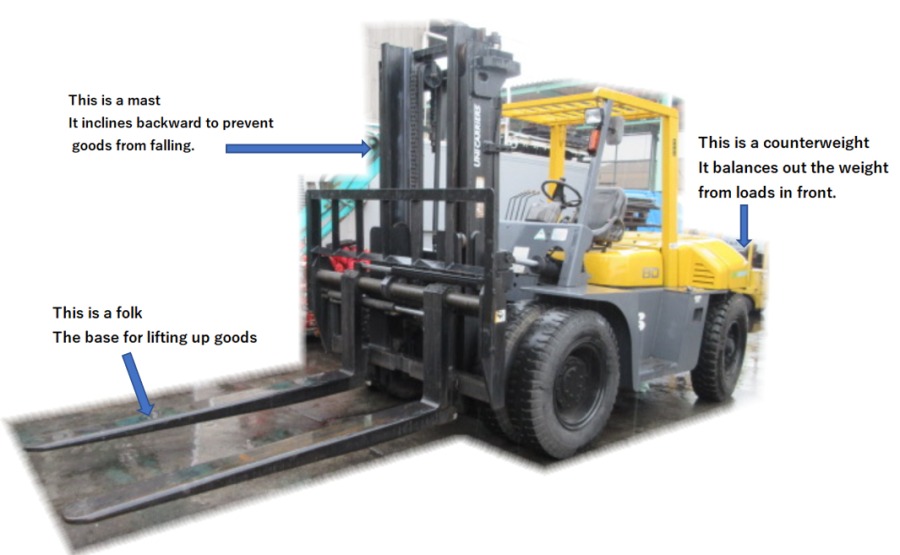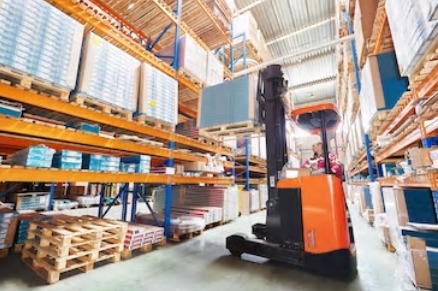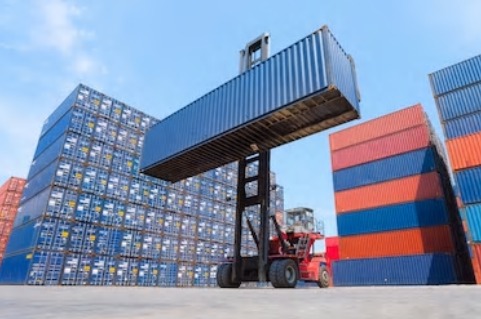BLOG
2019.02.22 update
ALL ABOUT FORKLIFT
HOW DOES FORKLIFT WORK?
Some of the forklifts are too small to look like construction equipment, but forklifts are equipment for carrying heavy things.
Understanding the various types of forklifts and lift trucks can help you to make a better decision about what type of new or used forklift is the best for your needs. Forklifts in general are defined as "Powered Industrial Lifts." Colloquially, all industrial lifts are called forklifts, though "lift truck" is probably a more accurate name, since some types of industrial lifts do not use the two parallel forks most commonly associated with forklifts. Alternative lift trucks either have platforms instead of forks or are tractor style trucks designed for moving attached carrying devices. This guide uses the terms "forklift" and "lift truck" interchangeably.
Let’s check out the parts!

Counterbalanced/Outrigger Lift Trucks
Some lift trucks are counterbalanced in order to prevent them from tipping over when carrying a load. This means that the truck body is heavily weighted to equal the lifting capacity of the forks. Others have outrigger extensions beneath the forks or platforms to balance the load and prevent tipping. Counterbalanced forklifts are ideal in all situations where outrigger extensions would impede or prevent the fork or platform's ability to access materials.
Forklift Masts
Forklift masts can be either fixed or have extendable (telescoping) vertical reach. Dual (or Duplex) masts have a single immovable mast plus one extendable section that lifts the forks and their carriage. Triple (or Triplex) and Quad masts have two and three extendable sections respectively. Having more extensions allows the forklift to have a lower overall height when the mast extensions are lowered and higher extended reach. Dual mast forklifts are the most common, while triple and quad masts are ideal for low vertical clearance situations, such as doorways.
Aisle Widths

There are three basic aisle types of forklifts: Wide Aisle (WA), Narrow Aisle (NA) and Very Narrow Aisle (VNA). Wide aisle forklifts (standard forklifts) require 11 feet or more of aisle space in order to maneuver. Narrow Aisle lift trucks can maneuver in 8-10 foot aisles. VNA trucks must be able to fit aisles 6 feet or less in width. These are specialty vehicles and include turret, swing mast and order selectors (or order pickers).
What’s the difference between electric powered or Internal combustion engines?
Electric lift trucks are powered by large, heavy batteries. They can be standard batteries or sealed, maintenance free batteries. Most batteries have sufficient storage power to last an entire shift before they need recharging. In order to extend and maximize their usefulness, manufacturers have come up with several innovative features:
• Quick Charge: Fast or Quick Charge batteries can be "topped up" during lunch breaks, between shifts or whenever the opportunity arises. This eliminates the need to change batteries between shifts.
• DC to AC Batteries: These batteries convert DC power to AC power. The result is improved efficiency, longer life and faster forklift acceleration.
• Regenerative Braking: The energy produced when braking is utilized to recharge the battery. Because forklift operators frequently use their brakes, this technology is ideal for lift trucks.
Internal combustion engines use a variety of fuels, including diesel, gasoline, LPG (Liquid Petroleum Gas) and compressed natural gas. Both electric and internal combustion powered forklifts are used indoors, though there are combustion and emissions safety hazards to be taken into account when operating fueled vehicles indoors. Gasoline and diesel are for outdoor use only and are the preferred fuels for use on rough terrain and other heavy duty lift trucks. LPG can safely be used indoors if there is sufficient ventilation.
Types of Lift Trucks
Standard: When the average person thinks of a forklift, they think of a Standard Lift Truck. This is a counterbalanced forklift and is only suitable for wide aisle applications. It may be electric powered or have an internal combustion engine and have either cushion or pneumatic tires. The most commonly used standard forklifts have a lifting capacity of 3000-4000 lbs.
Motorized Pallet Truck: This is a walk behind ("walkie") or stand-on platform ("rider") forklift. It functions very much like a standard pallet jack, but is suitable for heavier duty work. Motorized pallet trucks are ideal in larger warehouses and factories where pallets need to be moved frequently at near ground level over relatively long distances.
Reach Truck: Reach trucks are NA (Narrow Aisle) vehicles. They are variously called Stand-Up, Straddle or Double-deep reach trucks. Reach trucks are designed specifically for pallets stored in pallet racks. They are outrigger trucks with telescoping masts and a horizontally extendable/retractable scissor mechanism to "reach" out to a pallet and then retract, enabling the truck to maneuver in narrow aisles. The vertical reach of these trucks can be as high as 40 feet. Reach trucks are ideal for maximizing warehouse space.
Container forklift:

A container forklift is a piece of heavy machinery designed to lift and move large freight containers commonly used for freight shipping on boats or trains. These freight containers are quite large and heavy, so the container forklift is much larger and heavier duty than just about all other types of forklifts available. It usually features very large pneumatic tires for better maneuvering, especially over uneven terrain, and it usually runs on a heavy-duty diesel engine that can produce enough power and torque to help the machine lift the very large containers. The main purpose of a container forklift is to load and unload containers onto or off of truck beds, train cars, or even ships. The lift itself features a back plate for added support, and the forks are rated to handle the weight of a loaded container. The lift should not be used to lift containers beyond the lift's weight capabilities, which are usually posted somewhere prominent in the cockpit of the forklift.
ARE YOU LOOKING FOR FORKLIFTS?
Please check our website:
http://yamada-co.jp/en/stock/
If you cannot find your desired unit, please send us inquiry from the below link:
Contact Us: http://yamada-co.jp/en/contact/
---------------------------------------------------------------
Japanese Used Trucks & Machinery Exporter
Yamada Sharyo Co., Ltd.
Website / Contact Us / About Us
Search Trucks / Search Machinery
---------------------------------------------------------------
- LATEST ARTICLES
-
-

2022.04.05
Mitsubishi Fuso Truck and Bus Corporation Introduces New "Euro 4" Compliant Lineup to Indonesian Market
-

2022.03.22
We Opened Facebook Page and Instagram!
-

2022.03.08
Recent Best Sell!
-

2022.02.22
Japanese made excavator brand ‘YANMAR’
-

2022.01.05
Special Announcement ~AUCTION & EXPORT SERVICE STARTS!~
-
- CATEGORY
- ARCHIVES
-
- 2022-04(1)
- 2022-02(1)
- 2022-03(2)
- 2022-01(1)
- 2021-01(2)
- 2021-06(2)
- 2021-03(1)
- 2021-09(1)
- 2021-07(2)
- 2021-08(1)
- 2021-12(4)
- 2021-11(1)
- 2021-02(2)
- 2021-05(3)
- 2021-10(2)
- 2021-04(3)
- 2020-04(8)
- 2020-02(4)
- 2020-01(4)
- 2020-07(4)
- 2020-05(3)
- 2020-12(2)
- 2020-08(3)
- 2020-10(3)
- 2020-06(6)
- 2020-09(3)
- 2020-03(5)
- 2020-11(2)
- 2019-01(3)
- 2019-12(4)
- 2019-08(3)
- 2019-11(5)
- 2019-04(7)
- 2019-02(4)
- 2019-05(4)
- 2019-06(4)
- 2019-07(3)
- 2019-09(4)
- 2019-10(4)
- 2019-03(3)
- 2018-02(4)
- 2018-05(4)
- 2018-06(7)
- 2018-10(4)
- 2018-07(4)
- 2018-11(5)
- 2018-09(4)
- 2018-08(4)
- 2018-03(5)
- 2018-12(3)
- 2018-04(6)
- 2018-01(4)
- 2017-12(8)








